An Approach to Business Continuity Self-Assessment
Abstract
1. Introduction
2. Background Research
2.1. Business Continuity
2.2. Business Continuity Plan
2.3. Business Continuity Management
2.4. Standards and Models of Best Practices
- Objective planning and estimation;
- Effective monitoring of progress and performance against plans and objectives;
- Identification and resolution of process-related issues;
- Providing a basis for incorporating measurement into additional processes in the future.
2.5. Discussion on Measurement in the BCM Scope
3. Methodology
- Step 1—Identification of the problem and motivation: The relevance of the research problem to be tackled was identified, defined, and presented [17]. The research problem was identified as the lack of a standardized and comprehensive self-assessment methodology for BCM. Organizations face challenges in implementing BCM, such as high costs, lack of expertise, and insufficient top management awareness. There is a need for a structured self-assessment tool to evaluate BCM readiness, identify gaps, and improve organizational resilience. The problem was contextualized within the broader scope of BCM frameworks, standards, and best practices, as discussed in the background research.
- Step 2—Definition of the objectives of a solution: We defined what an improved artifact could accomplish and inferred the objectives of a solution from the definition of the problem and the knowledge of what is achievable and feasible [45]. The primary objective was to develop a Self-Assessment System that could help organizations evaluate their BCM readiness, identify gaps, and improve strategic alignment. The solution aimed to provide a structured and adaptable evaluation tool that could be used by organizations of all sizes, regardless of their current BCM adoption level. The Self-Assessment System was designed to integrate with any framework in the BCM scope. During the design phase, careful consideration was given to balancing comprehensiveness with usability to ensure that the Self-Assessment System could be adopted by organizations with varying levels of BCM maturity and resource availability. This balance was a key design decision grounded in DSR’s emphasis on artifact relevance and applicability.
- Step 3—Design and development: Artefact development to solve the identified problem following the defined objectives. It comprises stating the artifact’s desired functionality [69], its architecture, and the design of the prototype. The Self-Assessment System was designed to align with the BCM Model, which includes eight components and 118 activities. The eight components of the BCM Model were derived from a systematic literature review (SLR) of 167 publications, which identified recurring themes in BCM across sectors such as healthcare, finance, and energy. Key components—including Risk Assessment (RA), Business Impact Analysis (BIA), and ICT Strategy—were prioritized based on their frequency in the literature (e.g., RA appeared in 39 publications, BIA in 58) and their alignment with established standards like ISO 22301. Components such as ‘Emergency Response’ and ‘Crisis Management’ were added due to emerging trends in disaster resilience (e.g., 11 publications addressed natural disaster strategies). A structured set of questions was developed for each activity within the BCM Model components. Questions for each activity were formulated using evidence from the SLR, where specific gaps or best practices were highlighted (e.g., 23 publications emphasized cybersecurity measures in ICT Strategy, prompting dedicated questions on incident recovery). To ensure validity, questions were iteratively reviewed by a panel of five experts with >15 years of BCM experience, covering domains like risk management (16 years), ICT governance (21 years), and cybersecurity (22 years). Discrepancies were resolved through Delphi rounds until consensus was reached on clarity and relevance. These questions were designed to assess the organization’s alignment with BCM best practices and standards. The questions were weighted based on their relevance and importance to the overall BCM process. Weightings were empirically determined through two methods: (1) a frequency analysis of SLR findings (e.g., ‘ICT Strategy’ received higher weights due to representation in 129 publications, versus 11 for supply chain risks), and (2) expert scale scoring (1–5) during the Focus Group session. For instance, metrics tied to data recovery (RTO/RPO) were weighted 30% higher than generic policy checks, reflecting their critical role in 70% of disruption scenarios analyzed in the literature. The Self-Assessment System was formalized as a rapid assessment tool, enabling organizations to quickly evaluate their BCM readiness and identify critical issues. The system was designed to be user-friendly, with clear instructions and visual indicators (e.g., scorecards with color-coded results) to help users interpret their scores and identify areas for improvement. The artifact design followed an iterative development approach, allowing for continuous refinement based on expert feedback and empirical evaluation. This iterative process ensured that the Self-Assessment System was not only theoretically sound but also practically viable and responsive to real organizational contexts. The system underwent an iteration based on feedback from the Focus Group. For example, initial questions about ‘cloud-computing redundancy’ (from 11 SLR publications) were simplified after users noted technical complexity, while ‘crisis communication’ metrics were expanded following participant reports of ambiguity during simulated cyberattacks.
- Step 4—Demonstration: The feasibility of the artifact was demonstrated, allowing for an accurate assessment of its suitability for its purpose. With proof of concept, we demonstrated use of the artifact to address case scenarios through simulation. The resources required for the demonstration include adequate knowledge of how to use the artifact to solve the problem [65]. The Self-Assessment System was demonstrated through a Focus Group session with experts in business continuity, ICT governance, risk management, and cybersecurity. Participants were given a hands-on opportunity to interact with the system and simulate its application within their own organizations.
- Step 5—Evaluation: A design artifact’s utility, quality, and effectiveness must be rigorously demonstrated through well-performed evaluation methods [66]. The business context defines the criteria for artifact evaluation. The assessment involves integrating the artifact into the business’s technical infrastructure. How well the artifact supports a solution to the problem was observed and measured [44]. It included objective quantitative performance measures, using questionnaires to evaluate the artifact’s characteristics. This quantitative evaluation employed validated scales (1–5) according to the domain of the problem. Participants rated each attribute on, for example, clarity, relevance, and usability. Open-ended responses were thematically grouped to contextualize scores. BC experts and professionals in the ICT and BC area were selected from various activity sectors. We evaluated the artifact’s completeness and the quality of the changes resulting from the iterations [44]. The artifact evaluation enabled the development of a valid artifact aimed at reducing the identified problem. The evaluation strategy incorporated both qualitative and quantitative measures to rigorously assess the artifact’s utility, quality, and effectiveness. Participant responses were analyzed using a thematic analysis approach [70], combining deductive coding based on the 16 predefined attributes (e.g., clarity, adaptability) and inductive coding for emergent themes. The authors coded the Focus Group transcripts, with discrepancies resolved through consensus. To ensure validity, coded data were cross-validated against questionnaire responses for usability, relevance, and clarity metrics.By involving diverse stakeholders from different sectors, the study ensured comprehensive validation of the Self-Assessment System’s capability to identify BCM gaps and support continuous improvement.
- Step 6—Communication: Communicate the problem and its relevance, the Self-Assessment methodology artifact, its usefulness and novelty, the rigor of its design, and its effectiveness for researchers and professionals in the area. The importance and usefulness of the research and the various step results of the research were communicated to the scientific community, professionals, and interested organizations [44,45,64]. Our objective is to submit further scientific articles to journals to disseminate our findings and contributions widely. This research contributes to the DSR body of knowledge by providing a validated artifact that addresses a recognized gap in BCM assessment, demonstrating how design science principles can be effectively applied to develop tools that enhance organizational resilience and strategic management of BC.
4. Problem Identification and Motivation
5. Proposal
5.1. Objectives and Requirements
5.2. From Self-Assessment to Measurement
5.3. Self-Assessment System
- 1 *—The domain of the activity. It does not influence measurement.
- 2 *—The weighting (p) of activity A is referenced by pA. The sum of the weightings of all the essential activities in the component is 100.
- 3 *—Essential activities for the BCM Model component in the Self-assessment Methodology.
- 4 *—The question identification number.
- 5 *—The weighting (p) of question A1 in activity A. The sum of the question weightings for each activity is 100.
- 6 *—The self-assessment question no. 1 of activity A (A1), defined for domain X1. There may be multiple questions for a single activity.
- 7 *—The scorecard of the self-assessment question A1 (sA1). A value between 0 and 100 is accepted, represented by the semaphore. Red (<60), yellow (≥60 and <90), or green (≥90). The Self-Assessment System adopts the FAMMOCN maturity model, and the resulting score can be interpreted as an indicator of the organization’s relative maturity in BCM preparedness. The scoring scale uses visual semaphores: red, yellow, and green, which offer an intuitive view of performance:
- 8 *—The result of the self-assessment question is the product of the weighting in the activity (pA) by the metric weighting (pA1) and the entered value that defines the achievement of the intention defined in the self-assessment question (sA1). The weighted score of the question is referenced by spA1.
- 9 *—The component score is the sum of the weighted results of each self-assessment question. This value assumes values between 0 and 100.
- 1 *—The BCM Model component;
- 2 *—The number of questions answered out of the total of 61 questions defined. It is considered answered if the value is between 0 and 100;
- 3 *—The weighting (p) of the CA component is referenced by pCA. The sum of the weightings of all components is 100;
- 4 *—The score of the component resulting from its assessment (score) (see Table 2). A value between 0 and 100 is accepted, which is represented by the semaphore: red (≥ 0 and < 60), yellow (≥ 60 and < 90), or green (≥ 90 and ≤ 100);
- 5 *—The result of the component of the self-assessment is the product of the component weighting (pCA) by the value of the component score (score). The weighted score of the component is referenced by spCA;
- 6 *—The total score is the sum of the weighted results of each component. This value assumes values between 0 and 100.
5.4. Components
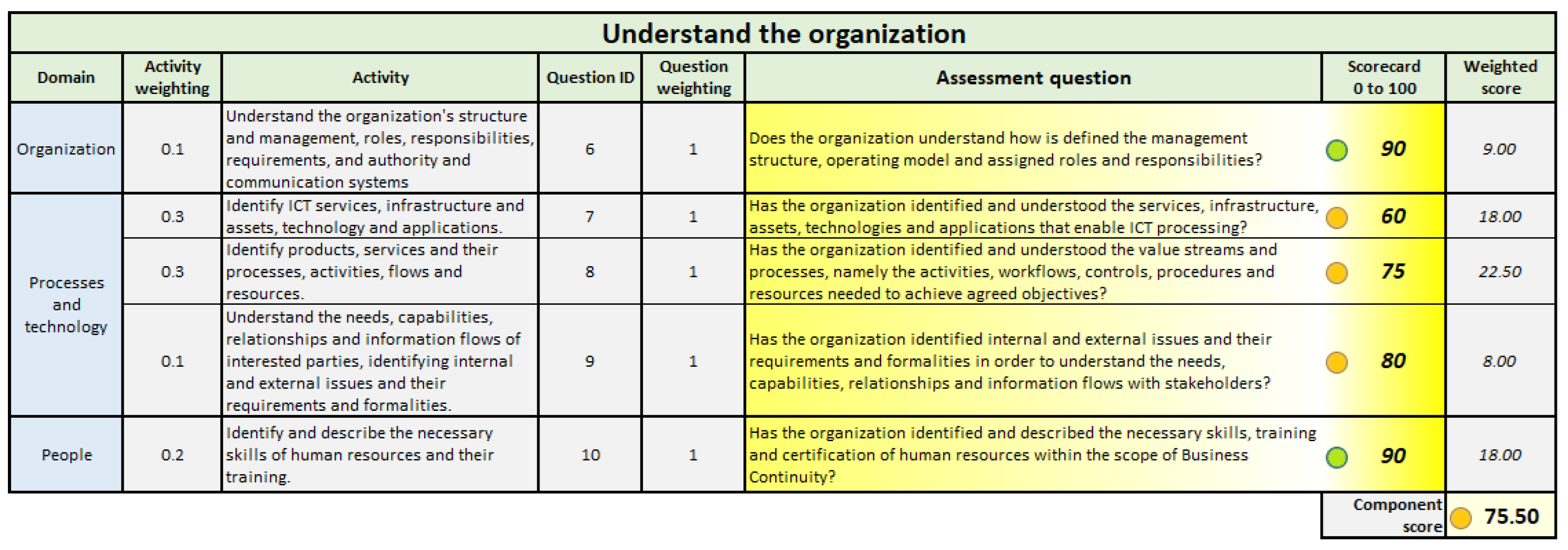


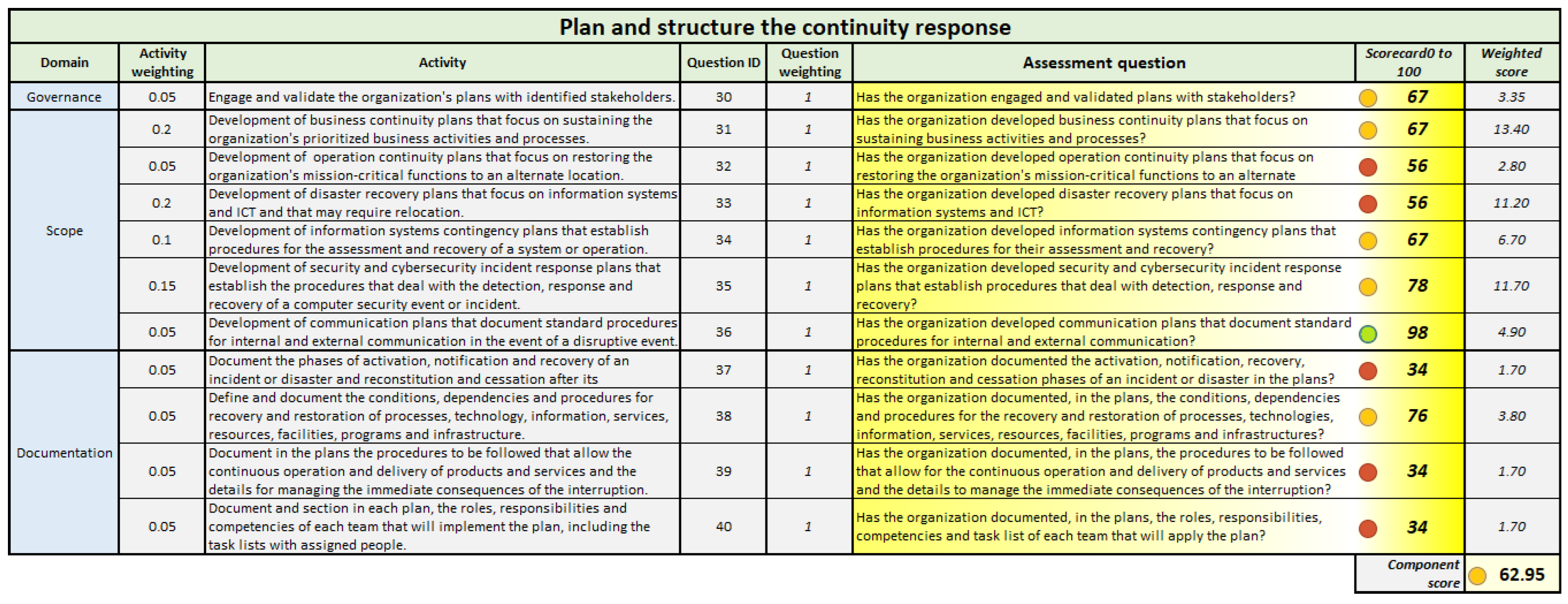
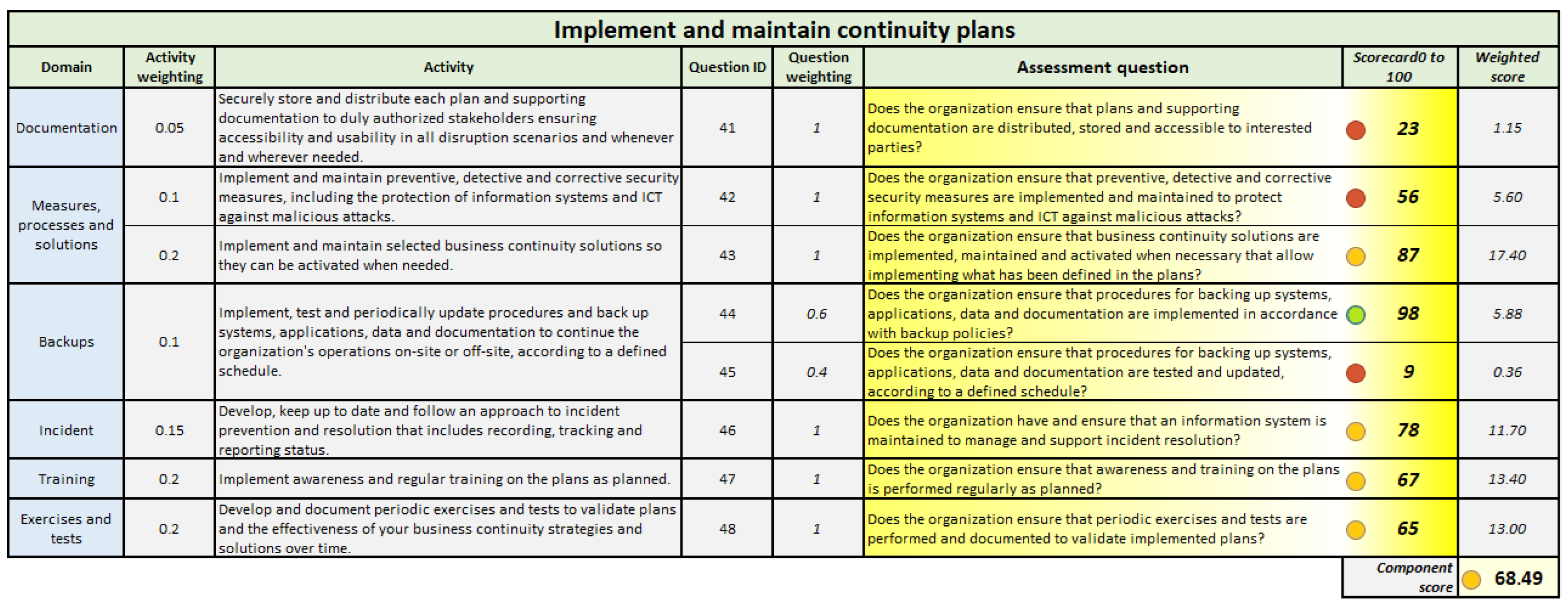
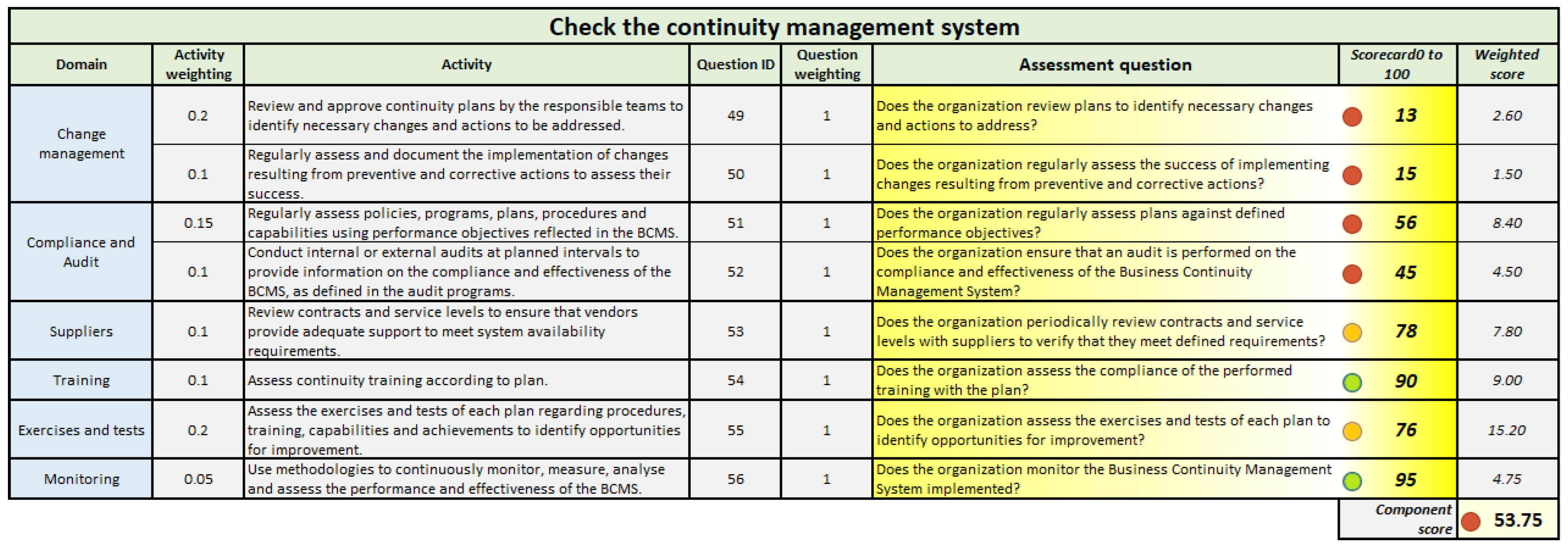

- Red: [0–60[ Implies the need for intervention. Value 0 indicates that the intents of the components must still be considered. At a score of <60, the components’ intents have been planned and are awaiting implementation.
- Yellow: [60–90[ Indicates the importance of understanding evolution. Value ≥ 60 indicates that component intents have begun. At a value of <90, the components’ intents are nearing completion.
- Green: [90–100[ Targets have been met, and no relevant intervention is required; nevertheless, adjustments may be necessary.
6. Demonstration
6.1. Focus Group Session
6.2. Results of the Demonstration
7. Evaluation
7.1. Evaluation Process
7.2. Semi-Structured Interviews
7.3. Overview of a Use Case
7.4. Key Findings and Refinements
8. Conclusions
Author Contributions
Funding
Institutional Review Board Statement
Informed Consent Statement
Data Availability Statement
Conflicts of Interest
Abbreviations
| BC | Business Continuity |
| BCM | Business Continuity Management |
| BCMS | Business Continuity Management System |
| BCP | Business Continuity Plan |
| BIA | Business Impact Analysis |
| CMMI | Capability Maturity Model Integration |
| COBIT | Control Objectives for Information and Related Technology |
| CR-SAT | Cyber Resilience Self-Assessment Tool |
| FAMMOCN | Framework for the Multidisciplinary Assessment of Organizational Maturity on Business Continuity Management |
| DSR | Design Science Research |
| ICT | Information and Communication Technologies |
| IS | Information Systems |
| ITIL | Information Technology Infrastructure Library |
| KPI | Key Performance Indicators |
| PDCA | Plan-Do-Check-Act |
| SLR | Systematic Literature Review |
References
- BCI. The Role of ICT in Ensuring Business Continuity. 22 July 2024. Available online: https://www.thebci.org/news/the-role-of-ict-in-ensuring-business-continuity.html (accessed on 12 February 2025).
- Katsaliaki, K.; Galetsi, P.; Kumar, S. Supply chain disruptions and resilience: A major review and future research agenda. Ann. Oper. Res. 2022, 319, 965–1002. [Google Scholar] [CrossRef] [PubMed]
- Ramakrishnan, R.K.; Viswanathan, S. The importance of Business Strategy in Business Continuity Planing. In The Definitive Handbook of Business Continuity Management, 3rd ed.; John Wiley & Sons, Ltd.: West Sussex, UK, 2011. [Google Scholar]
- Syed, A.; Syed, A. Business Continuity Planning Methodology; Sentryx: Austerlitz, The Netherlands, 2004. [Google Scholar]
- Cerullo, V.; Cerullo, M.J. Business Continuity Planning: A Comprehensive Approach. J. Inf. Syst. Manag. 2004, 21, 70–78. [Google Scholar] [CrossRef]
- Winkler, U.; Fritzsche, M.; Gilani, W.; Marshall, A. A Model-Driven Framework for Process-centric Business Continuity Management. In Proceedings of the 2010 Seventh International Conference on the Quality of Information and Communications Technology, Porto Portugal, 29 September–2 October 2010. [Google Scholar]
- Järveläinen, J. IT incidents and business impacts: Validating a framework for continuity management in information systems. Int. J. Inf. Manag. 2013, 33, 583–590. [Google Scholar] [CrossRef]
- Torabi, S.A.; Soufi, H.R.; Sahebjamnia, N. A new framework for business impact analysis in business continuity management (with a case study). Saf. Sci. 2014, 68, 309–323. [Google Scholar] [CrossRef]
- Torabi, S.A.; Giahi, R.; Sahebjamnia, N. An enhanced risk assessment framework for business continuity management systems. Saf. Sci. 2016, 89, 201–218. [Google Scholar] [CrossRef]
- Soufi, H.R.; Torabi, S.A.; Sahebjamnia, N. Developing a novel quantitative framework for business continuity planning. Int. J. Prod. Res. 2019, 57, 779–800. [Google Scholar] [CrossRef]
- Gracey, A. Building an organisational resilience maturity framework. J. Bus. Contin. Emerg. Plan. 2019, 13, 313–327. [Google Scholar] [CrossRef]
- Carías, J.F.; Arrizabalaga, S.; Labaka, L.; Hernantes, J. Cyber Resilience Self-Assessment Tool (CR-SAT) for SMEs. IEEE Access 2021, 9, 80741–80762. [Google Scholar] [CrossRef]
- Monev, V. The “Self-Assessment Method” within a Mature Third-Party Risk Management Process in the Context of Information Security. In Proceedings of the 2021 International Conference on Information Technologies (InfoTech), Varna, Bulgaria, 16–17 September 2021; pp. 1–7. [Google Scholar]
- NFPA 1600; NFPA 1600® Standard on Continuity, Emergency, and Crisis Management. National Fire Protection Association: Quincy, MA, USA, 2019.
- FFIEC. Business Continuity Management, USA: Federal Financial Institutions Examination Council (FFIEC) Information Technology Examination Handbook; FFIEC: Washington, DC, USA, 2019.
- Kato, M.; Charoenrat, T. Business continuity management of small and medium sized enterprises: Evidence from Thailand. Int. J. Disaster Risk Reduct. 2018, 27, 577–587. [Google Scholar] [CrossRef]
- Russo, N.; Reis, L.; Silveira, C.; Mamede, H.S. Framework for designing Business Continuity—Multidisciplinary Evaluation of Organizational Maturity. In Proceedings of the 6th Iberian Conference on Information Systems and Technologies (CISTI), Chaves, Portugal, 23–26 June 2021. [Google Scholar]
- Botha, J.; von Solms, R. A cyclic approach to business continuity planning. Inf. Manag. Comput. Secur. 2004, 12, 328–337. [Google Scholar] [CrossRef]
- Tjoa, S.; Jakoubi, S.; Quirchmayr, G. Enhancing Business Impact Analysis and Risk Assessment Applying a Risk-Aware Business Process Modeling and Simulation Methodology. In Proceedings of the 2008 Third International Conference on Availability, Reliability and Security, Barcelona, Spain, 4–7 March 2008. [Google Scholar]
- Valackienė, A.; Žostautienė, D. Changes Management as the Presumption for Business Continuity. Changes Soc. Bus. Environ. 2013, 207–212. [Google Scholar]
- Iovan, S.; Ivanus, C. Disaster Recovery and Business Continuity. Ann. Constantin Brancusi Univ. Targu-Jiu. Econ. Ser. 2013, 4, 153–158. [Google Scholar]
- Sterling, S. Encouraging resilience within SMEs: The Cabinet Office’s proposed approach. J. Bus. Contin. Emerg. Plan. 2011, 5, 128–139. [Google Scholar] [CrossRef]
- Arduini, F.; Morabito, V. Business continuity and the banking industry. Commun. ACM 2010, 53, 121–125. [Google Scholar] [CrossRef]
- Benyoucef, M.; Forzley, S. Business Continuity Planning and Supply Chain Management. Supply Chain Forum Int. J. 2007, 8, 14–22. [Google Scholar] [CrossRef]
- Shaw, G.; Harrald, J. The core competencies required of executive level business crisis and continuity managers—The results. J. Homel. Secur. Emerg. Manag. 2006, 3, 1–34. [Google Scholar] [CrossRef]
- Brás, J.; Guerreiro, S. Designing Business Continuity Processes Using DEMO: An Insurance Company Case Study. In Enterprise and Organizational Modeling and Simulation; EOMAS 2016. Lecture Notes in Business Information Processing; Pergl, R., Molhanec, M., Babkin, E., Fosso Wamba, S., Eds.; Springer: Berlin/Heidelberg, Germany, 2016; Volume 272. [Google Scholar]
- Pramudya, G.; Fajar, A. Business continuity plan using ISO 22301:2012 in IT solution company (pt. ABC). Int. J. Mech. Eng. Technol. 2019, 10, 865–872. [Google Scholar]
- Fani, S.V.; Subriadi, A.P. Business Continuity Plan: Examining of Multi-Usable Framework. Procedia Comput. Sci. 2019, 161, 275–282. [Google Scholar] [CrossRef]
- Herbane, B.; Elliott, D.; Swartz, M. Business Continuity Management: Time for a strategic role? Long Range Plan. 2004, 37, 435–457. [Google Scholar] [CrossRef]
- Putra, E.P.P.; Nazief, B.A.A. Analysis of Main Cause Factors and Improvement Recommendation of IT Disaster Recovery Problems: A Case Study of XYZ Organization. AIP Conf. Proc. 2018, 1977, 020024. [Google Scholar]
- Burtles, J. Manager’s Guide to Business Continuity Exercises: Testing Your Plan. In Rothstein Publishing eBook Collection; Rothstein Publishing: Brookfield, CT, USA, 2016. [Google Scholar]
- Păunescu, C. How Prepared are Small and Medium Sized Companies for Business Continuity Management? Qual.-Access Success 2017, 18, 43–48. [Google Scholar]
- Veerasamy, N.; Mashiane, T.; Pillay, K. Contextualising cybersecurity readiness in South Africa. In Proceedings of the 14th International Conference on Cyber Warfare and Security, Stellenbosch, South Africa, 28 February–1 March 2019. [Google Scholar]
- Ohlhausen, P.E.; McGarvey, D. The use of metrics to manage enterprise security risks: Understanding, evaluation and persuasion. J. Bus. Contin. Emerg. Plan. 2018, 12, 6–16. [Google Scholar] [CrossRef]
- Moody, G.D.; Siponen, M.; Pahnila, S. Toward a Unified Model of Information Security Policy Compliance. MIS Q. 2018, 42, 285–312. [Google Scholar] [CrossRef]
- Hiles, A. Business Continuity Management: Global Best Practices; Rothstein Publishing: Brookfiel, CT, USA, 2014. [Google Scholar]
- ISO 22301; Societal Security—Business Continuity Management Systems—Requirements. ISO: Geneve, Switzerland, 2019.
- ISO/IEC 27031; Information Technology—Security Techniques—Guidelines for Information and Communication Technology Readiness for Business Continuity. ISO/IEC: Geneve, Switzerland, 2011.
- ISO 22300; Security and Resilience—Vocabulary. ISO: Geneve, Switzerland, 2021.
- Fernando, M.S. IT disaster recovery system to ensure the business continuity of an organization. In Proceedings of the 2017 National Information Technology Conference (NITC), Colombo, Sri Lanka, 14–15 September 2017. [Google Scholar]
- Vasquez, E.J.; Ortega, J.C. Design of a business contingency plan. Case study: Municipality of Cantón Suscal. In Proceedings of the 2020 International Conference on Intelligent Systems and Computer Vision (ISCV), Fez, Morocco, 9–11 June 2020. [Google Scholar]
- Brás, J. Bootstrapping Enterprise Models with Business Continuity Processes and DEMO. 2018. Available online: https://recil.ulusofona.pt/items/ca18f831-c912-45e8-9e3e-dcae13b1bb42 (accessed on 12 February 2025).
- Aronis, S.; Stratopoulos, G. Implementing business continuity management systems and sharing best practices at a European bank. J. Bus. Contin. Emerg. Plan. 2016, 9, 203–217. [Google Scholar] [CrossRef]
- Russo, N.; Mamede, H.S.; Reis, L.; Silveira, C. FAMMOCN—Demonstration and evaluation of a framework for the multidisciplinary assessment of organisational maturity on business continuity. Heliyon 2022, 8, e10566. [Google Scholar] [CrossRef]
- Russo, N.; Reis, L.; Silveira, C.; Mamede, H.S. Towards a Comprehensive Framework for the Multidisciplinary Evaluation of Organizational Maturity on Business Continuity Program Management: A Systematic Literature Review. Inf. Secur. J. A Glob. Perspect. 2023, 33, 54–72. [Google Scholar] [CrossRef]
- CMMI Institute. CMMI Model V2.0; CMMI Institute: Pittsburgh, PA, USA, 2018. [Google Scholar]
- ITIL. ITIL Foundation ITIL 4 Edition; AXELOS: London, UK, 2019. [Google Scholar]
- ISACA. COBIT 2019 Framework—Governance, Management Objectives; ISACA: Schaumburg, IL, USA, 2018. [Google Scholar]
- NIST. NIST Special Publication 800-34 Rev. 1—Contingency Planning Guide for Federal Information Systems; National Institute of Standards and Technology: Gaithersburg, MD, USA, 2010.
- Marshall, M. How to develop a risk assessment programme for your vendor’s BCP capabilities and their impact on your organisation. J. Bus. Contin. Emerg. Plan. 2007, 1, 340–347. [Google Scholar] [CrossRef]
- Trousdale, L. Using self-assessments to enhance business continuity programmes. J. Bus. Contin. Emerg. Plan. 2015, 9, 6–9. [Google Scholar] [CrossRef]
- Tomsic, H. Auditing emergency management programmes: Measuring leading indicators of programme performance. J. Bus. Contin. Emerg. Plan. 2016, 10, 57–75. [Google Scholar] [CrossRef]
- Iqbal Widyawan, A.; Mustika, I.W. COBIT 5 domain delivery, service and support mapping for business continuity plan. AIP Conf. Proc. 2016, 1746, 020045. [Google Scholar]
- Vaidyanathan, K. Post-event reviews: Using a quantitative approach for analysing incident response to demonstrate the value of business continuity programmes and increase planning efficiency. J. Bus. Contin. Emerg. Plan. 2017, 11, 107–116. [Google Scholar] [CrossRef]
- Harding, M. Moving your business continuity management programme forward with recoverability measurement. J. Bus. Contin. Emerg. Plan. 2018, 12, 113–118. [Google Scholar] [CrossRef]
- Ricks, M.; Boswell, L. Assessing the resilience of an IT portfolio. J. Bus. Contin. Emerg. Plan. 2019, 13, 22–31. [Google Scholar] [CrossRef]
- Bajgorić, N.; Turulja, L.; Ibrahimović, S.; Alagić, A. Enhancing Business Continuity and IT Capability: System Administration and Server Operating Platforms; CRC Press: Boca Raton, FL, USA, 2020. [Google Scholar]
- Gallagher, M. Business Continuity Management—Do you measure up? Account. Irel. 2003, 35, 15–16. [Google Scholar]
- Gardner, B. An Exploratory Qualitative Inquiry of Key Indicators on IT Disaster Recovery Planning. Ph.D. Thesis, Capella University, Minneapolis, MN, USA, 2016. [Google Scholar]
- Ream, S.; Mathew, S. A metrics framework to get and keep management engaged. J. Bus. Contin. Emerg. Plan. 2018, 11, 298–308. [Google Scholar] [CrossRef]
- Zeng, Z.; Zio, E. An integrated modeling framework for quantitative business continuity assessment. Process Saf. Environ. Prot. Trans. Inst. Chem. Eng. Part B 2017, 106, 76–88. [Google Scholar] [CrossRef]
- Olson, A.; Anderson, J. Resiliency scoring for business continuity plans. J. Bus. Contin. Emerg. Plan. 2016, 10, 31–43. [Google Scholar] [CrossRef]
- Stourac, T. Wheels, hubs and spokes: Incorporating a scorecard into a business continuity programme. J. Bus. Contin. Emerg. Plan. 2014, 7, 260–269. [Google Scholar] [CrossRef]
- Russo, N.; Mamede, H.S.; Reis, L.; Martins, J.; Branco, F. Exploring a Multidisciplinary Assessment of Organisational Maturity in Business Continuity: A Perspective and Future Research Outlook. Appl. Sci. 2023, 13, 11846. [Google Scholar] [CrossRef]
- Peffers, K.; Tuunanen, T.; Rothenberger, M.A.; Chatterjee, S. A Design Science Research Methodology for Information Systems Research. J. Manag. Inf. Syst. 2007, 24, 45–77. [Google Scholar] [CrossRef]
- Hevner, A.R.; March, S.T.; Park, J.; Ram, S. Design Science in Information Systems Research. Manag. Inf. Syst. Q. 2004, 28, 75–105. [Google Scholar] [CrossRef]
- Ferreira, I.; Ferreira, S.; Silva, C.; Carvalho, J. Dilemas iniciais na investigação em TSI. In Proceedings of the Atas da Conferencia Ibérica de Sistemas y Tecnologias de Informacíon (7ª CISTI), Madrid, Spain, 20–23 June 2012. [Google Scholar]
- Hiles, A. Business Continuity: Best Practices: World-Class Business Continuity Management; Rothstein Associates Inc.: Brookfield, CT, USA, 2004. [Google Scholar]
- Russo, N.; Reis, L. Chapter 10—Methodological Approach to Systematization of Business Continuity in Organizations. In Handbook of Research on Multidisciplinary Approaches to Entrepreneurship, Innovation, and ICTs; IGI Global: Hershey, PA, USA, 2020; pp. 200–223. [Google Scholar]
- Clarke, V.; Braun, V. Thematic analysis. J. Posit. Psychol. 2016, 12, 297–298. [Google Scholar] [CrossRef]
- Wong, W.N.Z. The strategic skills of business continuity managers: Putting business continuity management into corporate long-term planning. J. Bus. Contin. Emerg. Plan. 2009, 4, 62–68. [Google Scholar] [CrossRef]
- Russo, N.; Reis, L. Updated analysis of business continuity issues underlying the certification of invoicing software, considering a pandemic scenario. Adv. Sci. Technol. Eng. Syst. J. 2020, 5, 845–852. [Google Scholar] [CrossRef]
- Bethany, M.P. Business Continuity Planning: Identifying Gaps, Patterns and Justifications; California State University: Long Beach, CA, USA, 2014. [Google Scholar]
- Gallo, U.E. Implementación de un Sistema Integrado de Gestión Basado en los Estándares ISO 27001, ISO 31000 e ISO 22301 en la Empresa Paris & Asociados, S.A.C; Universidad Nacional Mayor de San Marcos: Lima, Perú, 2021. [Google Scholar]
- Sahebjamnia, N.; Torabi, S.A.; Mansouri, S.A. Integrated business continuity and disaster recovery planning: Towards organizational resilience. Eur. J. Oper. Res. 2015, 242, 261–273. [Google Scholar] [CrossRef]
- Hamid, A.H.A. Limitations and challenges towards an effective business continuity management in Nuklear Malaysia. In Proceedings of the IOP Conference Series: Materials Science and Engineering, Xi’an, China, 24–26 June 2018. [Google Scholar]
- Green, C. Measuring business continuity programmes in large organisations. J. Bus. Contin. Emerg. Plan. 2014, 8, 71–82. [Google Scholar] [CrossRef]
- Ford, M.W.; Evans, J.R. Models for organizational self-assessment. Business horizons. Bus. Horiz. 2002, 45, 25–32. [Google Scholar] [CrossRef]
- Pinto, D.; Fernandes, A.; da Silva, M.; Pereira, R. Maturity models for business continuity–A systematic literature review. Int. J. Saf. Secur. Eng. 2022, 12, 123–136. [Google Scholar] [CrossRef]
- Fani, S.V.; Subiadi, A.P. Trend of Business Continuity Plan: A Systematic Literature Review. In Proceedings of the 1st International Conference on Business, Law And Pedagogy, ICBLP 2019, Sidoarjo, Indonesia, 13–15 February 2019. [Google Scholar]
- Ostadi, B.; Ebrahimi-Sadrabadi, M.; Sepehri, M.M.; Kashan, A.H. A Systematic Literature Review of Organization Resilience, Business Continuity, and Risk: Towards Process Resilience and Continuity. Interdiscip. J. Manag. Studies 2023, 16, 229–257. [Google Scholar]
- Tremblay, M.C.; Hevner, A.R.; Berndt, D.J.; Chatterjee, S. The use of focus groups in design science research. Des. Res. Inf. Syst. 2010, 22, 121–143. [Google Scholar]
- Revilla, E.; Saenz, M.J. The impact of risk management on the frequency of supply chain disruptions: A configurational approach. Int. J. Oper. Prod. Manag. 2017, 37, 557–576. [Google Scholar] [CrossRef]

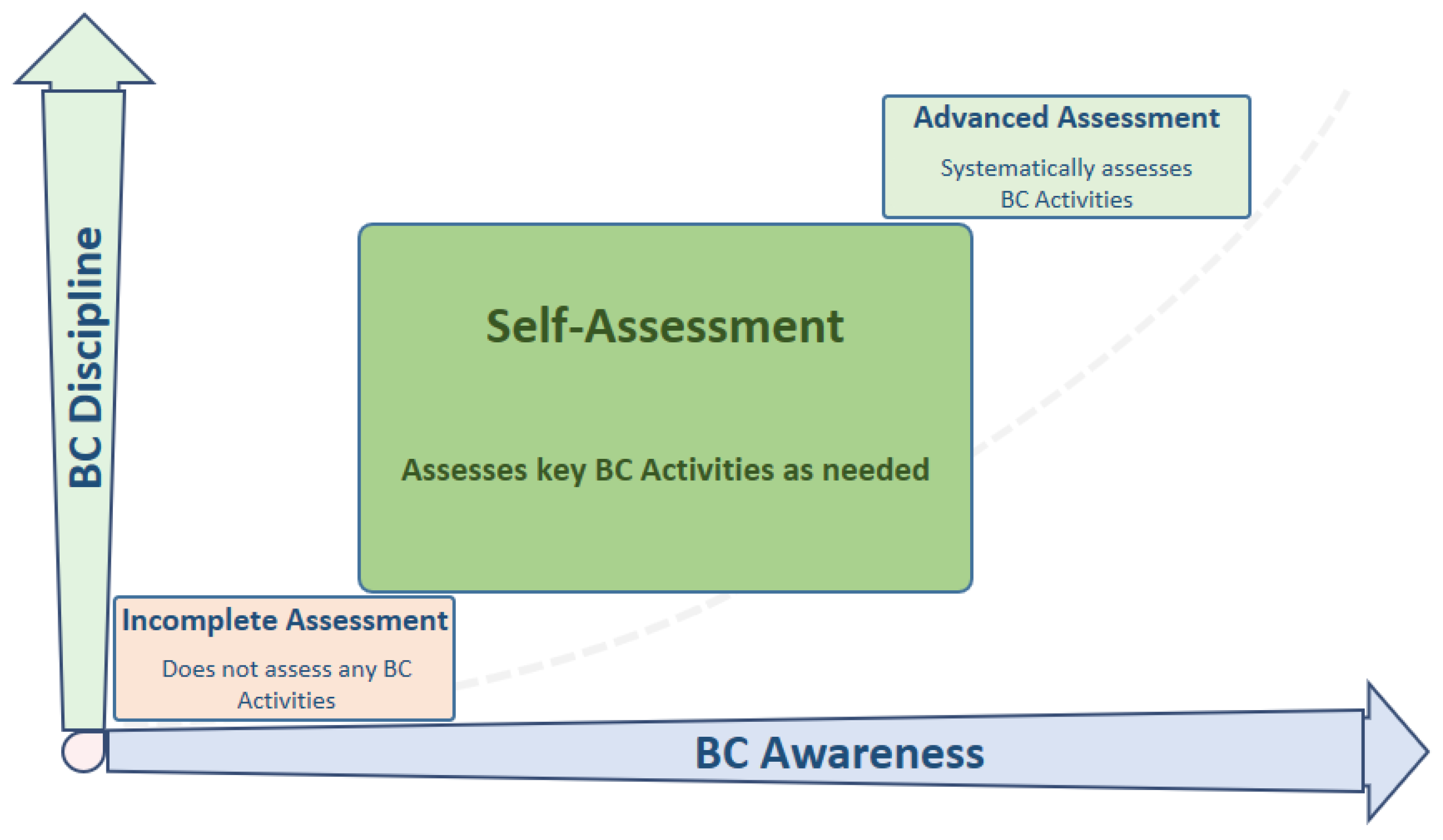
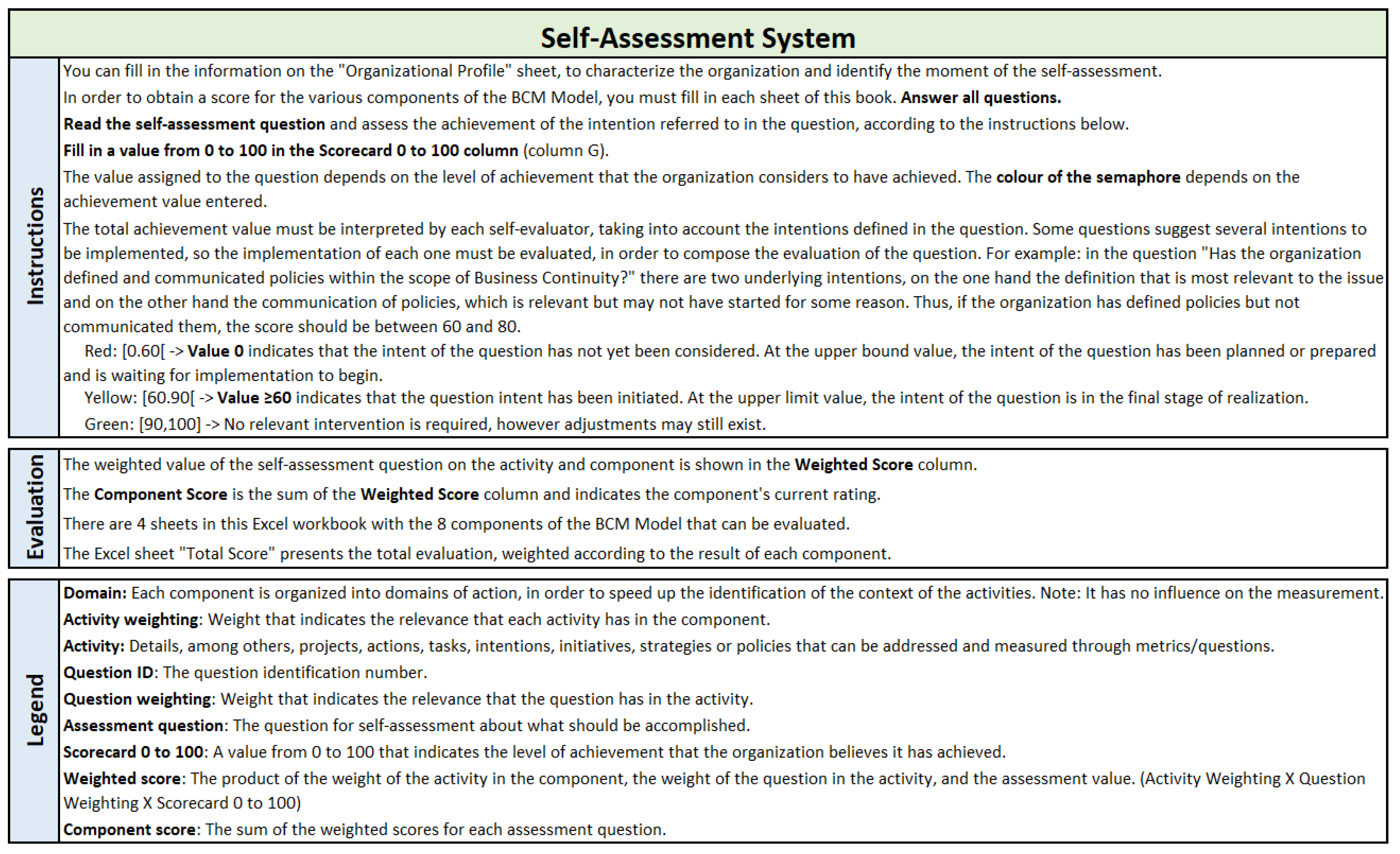
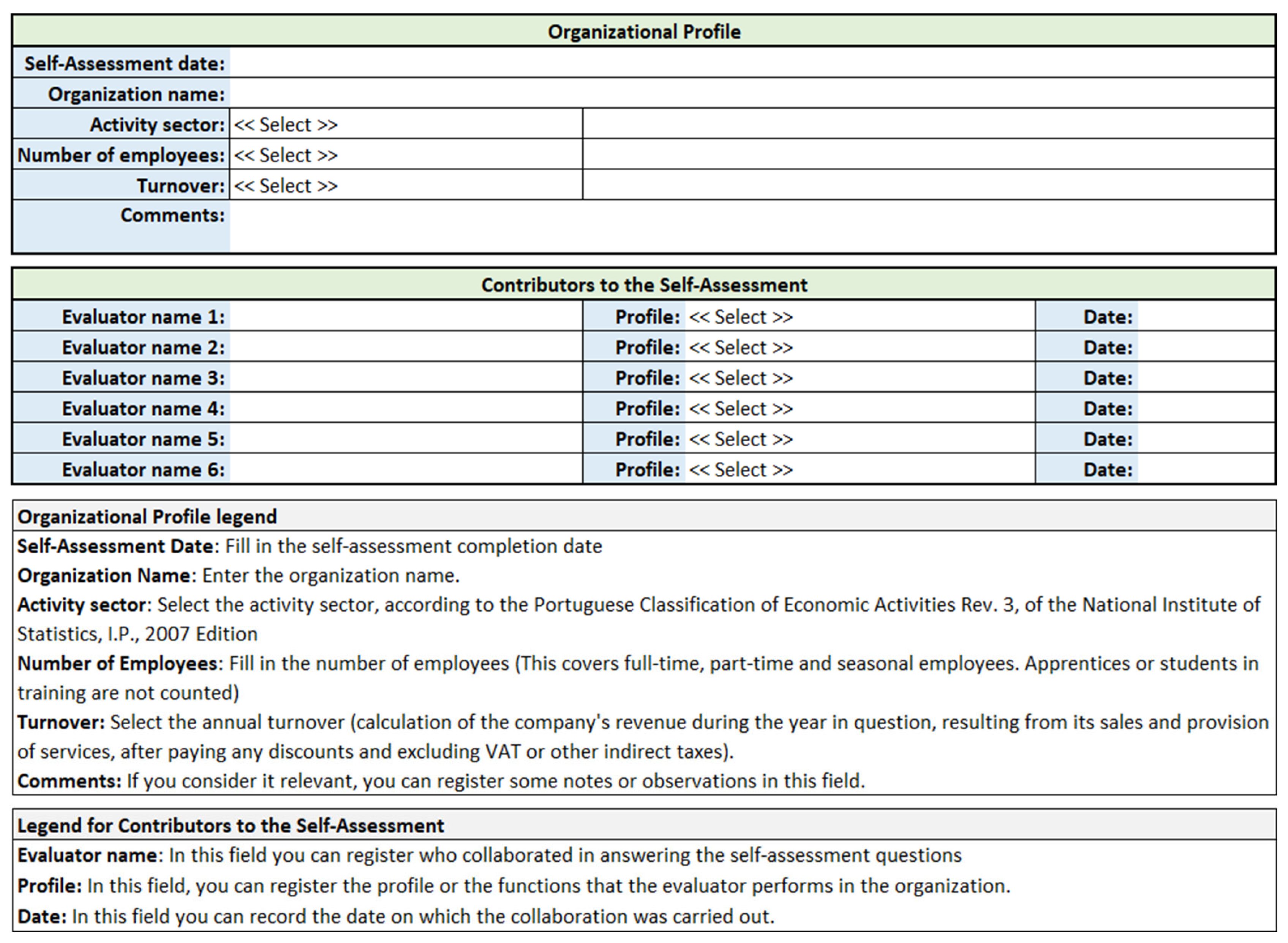
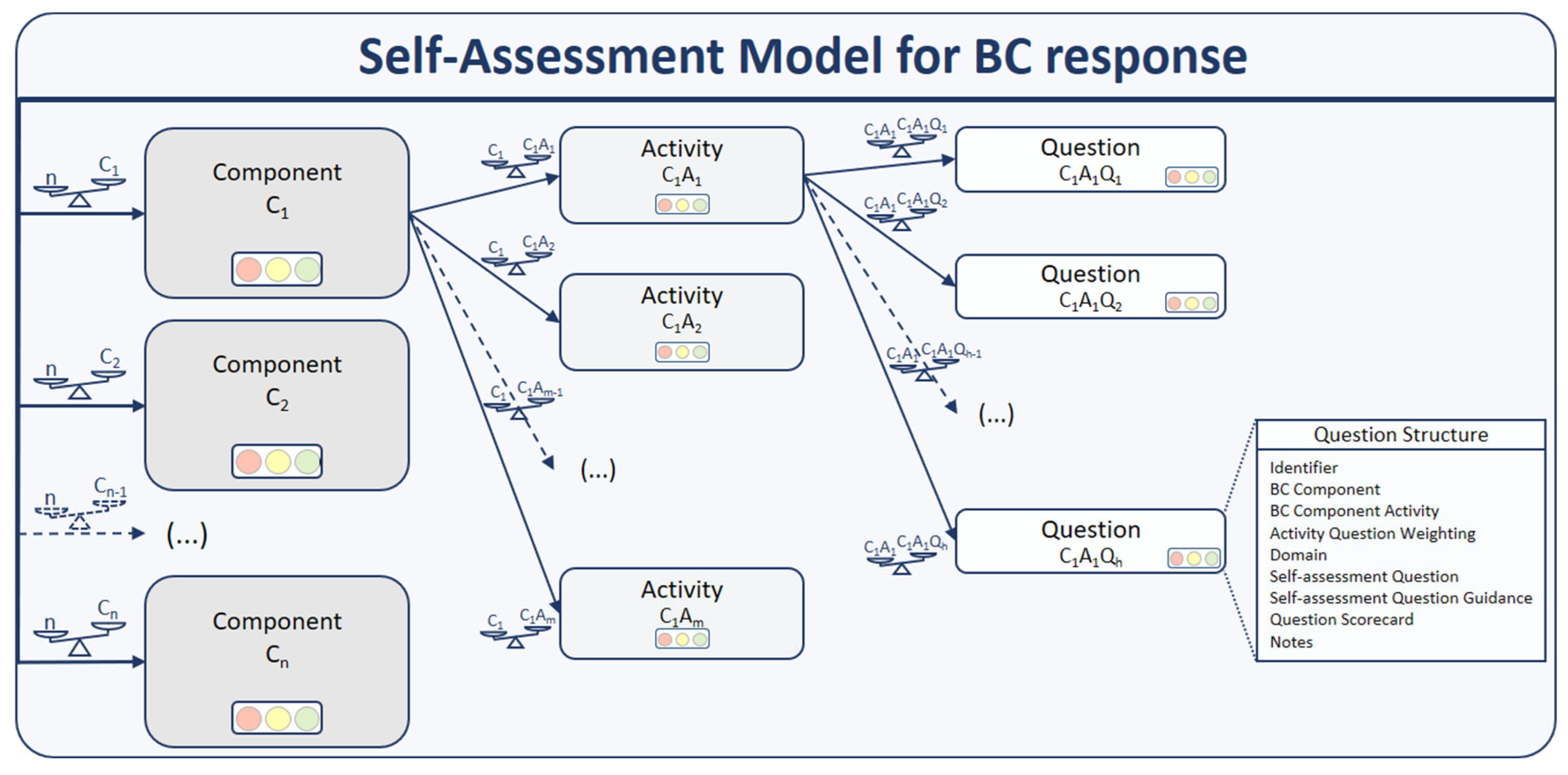

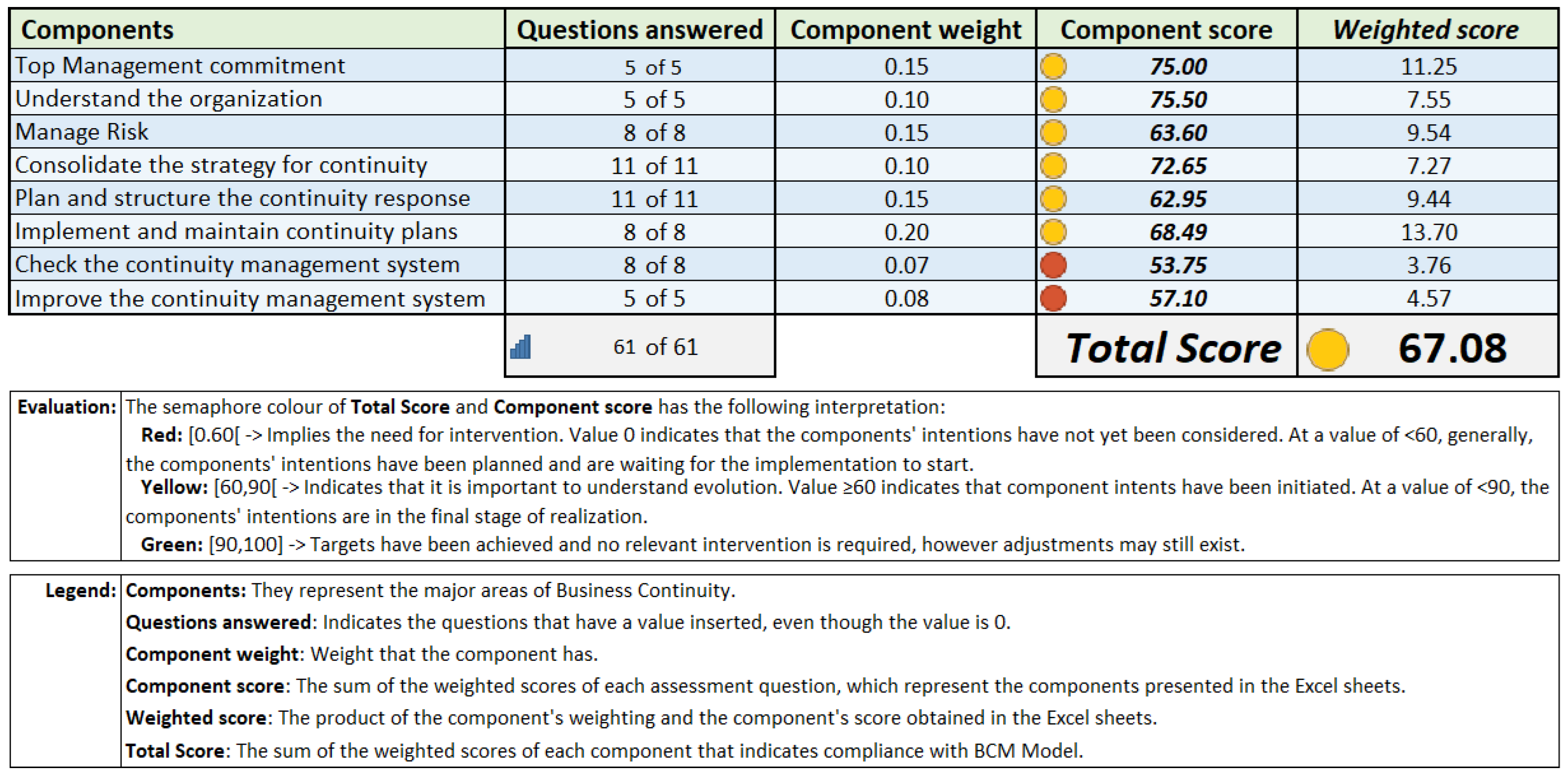
| Attribute | Description | Classification |
|---|---|---|
| Identifier | Question identification number | Identification |
| BC Component | BC component identification | |
| BC Component Activity | Activity identification in the BC component | |
| Activity Question Weighting | Weight of the question to achieve the intention of the activity | |
| Domain | The field of action | |
| Self-assessment Question | The question for self-assessment about what should be accomplished | Self-assessment |
| Self-assessment Question Guidance | Guidelines for direct measurement in self-assessment, suggesting what should be achieved in each color of the scorecard | |
| Question Scorecard | The percentage range of accumulated measurements according to the goal of defining the color of the scorecard | Achievement |
| Notes | Relevant comments on any parameter | Evidence |
| Domain | Activity Weighting | Activity | Question ID | Question Weighting | Self-Assessment Question | Scorecard 0 to 100 | Weighted Score |
|---|---|---|---|---|---|---|---|
| Domain X1 (1 *) | pA (2 *) | Activity A (3 *) | # (4 *) | pA1 (5 *) | Question A1 (6 *) | sA1 (7 *) | pA x pA1 × sA1 = spA1 (8 *) |
| # | pA2 | Question A2 | sA2 | pA x pA2 × sA2 = spA2 | |||
| Domain X2 | pB | Activity B | # | pB1 | Question B1 | sB1 | pB x pB1 × sB1 = spB1 |
| # | pB2 | Question B2 | sB2 | pB x pB2 × sB2 = spB2 | |||
| pC | Activity C | # | pC1 | Question C1 | sC1 | pC x pC1 × sC1 = spC1 | |
| Domain X3 | pD | Activity D | # | pD1 | Question D1 | sD1 | pD x pD1 × sD1 = spD1 |
| Component Score | spA1 + spA2 + spB1 + spB2 + spC2 + spD1 (9 *) | ||||||
| BCM Model component | Answered Questions | Component Weighting | Component Score | Weighted Score |
|---|---|---|---|---|
| Top Management commitment (1 *) | # of 5 (2 *) | pCA (3 *) | scoreCA (4 *) | pCA × scoreCA = spCA (5 *) |
| Understand the organization | # of 5 | pCB | scoreCB | pCB × scoreCB = spCB |
| Manage Risk | # of 8 | pCC | scoreCC | pCC × scoreCC = spCC |
| Consolidate the strategy for continuity | # of 11 | pCD | scoreCD | pCD × scoreCD = spCD |
| Plan and structure the continuity response | # of 11 | pCE | scoreCE | pCE × scoreCE = spCE |
| Implement and maintain continuity plans | # of 8 | pCF | scoreCF | pCF × scoreCF = spCF |
| Check the continuity management system | # of 8 | pCG | scoreCG | pCG × scoreCG = spCG |
| Improve the continuity management system | # of 5 | pCH | scoreCH | pCH × scoreCH = spCH |
| # of 61 | Total Score | spCA + spCB + spCC + + spCD + spCE + spCF + + spCG + spCH (6 *) |
Disclaimer/Publisher’s Note: The statements, opinions and data contained in all publications are solely those of the individual author(s) and contributor(s) and not of MDPI and/or the editor(s). MDPI and/or the editor(s) disclaim responsibility for any injury to people or property resulting from any ideas, methods, instructions or products referred to in the content. |
© 2025 by the authors. Licensee MDPI, Basel, Switzerland. This article is an open access article distributed under the terms and conditions of the Creative Commons Attribution (CC BY) license (https://creativecommons.org/licenses/by/4.0/).
Share and Cite
Russo, N.; São Mamede, H.; Reis, L. An Approach to Business Continuity Self-Assessment. Technologies 2025, 13, 242. https://doi.org/10.3390/technologies13060242
Russo N, São Mamede H, Reis L. An Approach to Business Continuity Self-Assessment. Technologies. 2025; 13(6):242. https://doi.org/10.3390/technologies13060242
Chicago/Turabian StyleRusso, Nelson, Henrique São Mamede, and Leonilde Reis. 2025. "An Approach to Business Continuity Self-Assessment" Technologies 13, no. 6: 242. https://doi.org/10.3390/technologies13060242
APA StyleRusso, N., São Mamede, H., & Reis, L. (2025). An Approach to Business Continuity Self-Assessment. Technologies, 13(6), 242. https://doi.org/10.3390/technologies13060242







